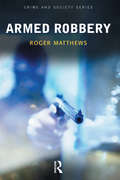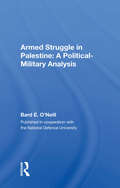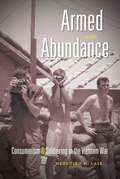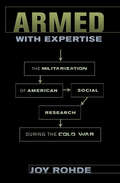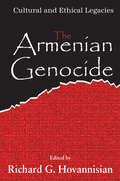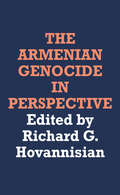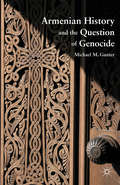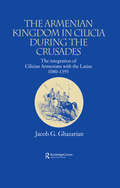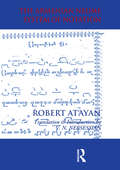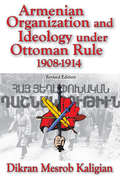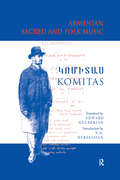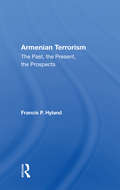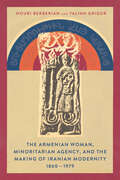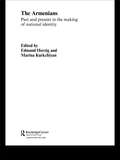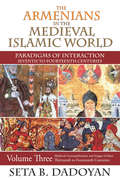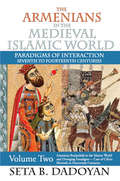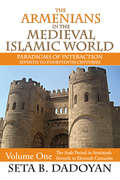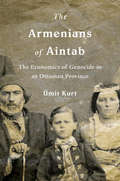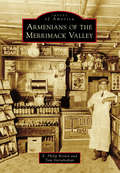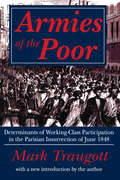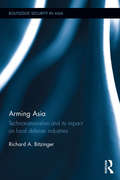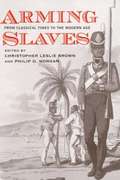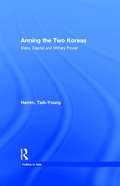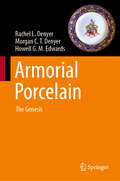- Table View
- List View
Armed Robbery (Crime and Society Series)
by Roger MatthewsDespite the significance of armed robbery in the criminal justice system, the media and in the public mind there has been little systematic research or writing on the subject beyond the popular accounts. In both the USA and the UK there remains a large gap in the literature on the subject, which this book aims to fill. It provides a comprehensive account of armed robbery, based on extensive research with 350 armed robbers in prison, and on work with two police armed response units Despite the significance of armed robbery in the criminal justice system, the media and in the public mind there has been little systematic research or writing on the subject beyond the popular accounts – from the Metropolitan and South Yorkshire Police. This is the book on the subject.
Armed Struggle In Palestine: A Political-military Analysis
by Bard E. O'neillBard O'Neill investigates the Palestinian guerrilla movement and assesses the probability that the fedayeen will achieve their aim of liberating Palestine-including Israel-by means of protracted revolutionary insurgency. His analytic framework incorporates several factors that have a critical bearing on the outcomes of protracted insurgencies; thes
Armed with Abundance
by Meredith H. LairPopular representations of the Vietnam War tend to emphasize violence, deprivation, and trauma. By contrast, in Armed with Abundance, Meredith Lair focuses on the noncombat experiences of U.S. soldiers in Vietnam, redrawing the landscape of the war so that swimming pools, ice cream, visits from celebrities, and other "comforts" share the frame with combat.To address a tenuous morale situation, military authorities, Lair reveals, wielded abundance to insulate soldiers--and, by extension, the American public--from boredom and deprivation, making the project of war perhaps easier and certainly more palatable. The result was dozens of overbuilt bases in South Vietnam that grew more elaborate as the war dragged on. Relying on memoirs, military documents, and G.I. newspapers, Lair finds that consumption and satiety, rather than privation and sacrifice, defined most soldiers' Vietnam deployments. Abundance quarantined the U.S. occupation force from the impoverished people it ostensibly had come to liberate, undermining efforts to win Vietnamese "hearts and minds" and burdening veterans with disappointment that their wartime service did not measure up to public expectations. With an epilogue that finds a similar paradigm at work in Iraq, Armed with Abundance offers a unique and provocative perspective on modern American warfare.
Armed with Expertise: The Militarization of American Social Research during the Cold War (American Institutions and Society)
by Joy RohdeDuring the height of the wars in Iraq and Afghanistan, the Pentagon launched a controversial counterinsurgency program called the Human Terrain System. The program embedded social scientists within military units to provide commanders with information about the cultures and grievances of local populations. Yet the controversy it inspired was not new. Decades earlier, similar national security concerns brought the Department of Defense and American social scientists together in the search for intellectual weapons that could combat the spread of communism during the Cold War. In Armed with Expertise, Joy Rohde traces the optimistic rise, anguished fall, and surprising rebirth of Cold War–era military-sponsored social research.Seeking expert knowledge that would enable the United States to contain communism, the Pentagon turned to social scientists. Beginning in the 1950s, political scientists, social psychologists, and anthropologists optimistically applied their expertise to military problems, convinced that their work would enhance democracy around the world. As Rohde shows, by the late 1960s, a growing number of scholars and activists condemned Pentagon-funded social scientists as handmaidens of a technocratic warfare state and sought to eliminate military-sponsored research from American intellectual life.But the Pentagon's social research projects had remarkable institutional momentum and intellectual flexibility. Instead of severing their ties to the military, the Pentagon’s experts relocated to a burgeoning network of private consulting agencies and for-profit research offices. Now shielded from public scrutiny, they continued to influence national security affairs. They also diversified their portfolios to include the study of domestic problems, including urban violence and racial conflict. In examining the controversies over Cold War social science, Rohde reveals the persistent militarization of American political and intellectual life, a phenomenon that continues to raise grave questions about the relationship between expert knowledge and American democracy.
Armenia and Imperial Decline: The Yerevan Province, 1900-1914 (Routledge Advances in Armenian Studies)
by George BournoutianThis book seeks, for the first time, to examine the demography and the social and economic conditions in the Yerevan Province during the first decade of the twentieth century, before the great changes that occurred during World War I and the seven decades of Soviet rule. Unlike in Tiflis and Baku, the Armenian inhabitants of the Yerevan Province were overwhelmingly peasants. They did not play a major role in the political, intellectual or economic life of the South Caucasus. The aim of the book is to prove conclusively that the Armenians of the Yerevan Province not only benefited from living under the umbrella of imperial security, but, as junior and senior officials, they also acquired important administrative and professional skills. The social and economic changes of the last decade of Russian rule enabled the local Armenians to advance and, following the collapse of the Russian Empire, to occupy posts previously held by Russians. Thus, despite the absence of their most talented individuals and the lack of experienced political leaders, as well as the loss of half their territory to Turkish attacks in 1918, the local Armenian administration, in the face of terrible conditions and great odds, provided the foundation which allowed the Armenian Republic to maintain its independence until December of 1920. In fact, some of the survivors would assist in the modernization and nation building of Soviet Armenia. Providing a detailed overview of the history of the Yerevan Province in the late imperial age, this book will be a valuable resource for students and scholars interested in the History of Armenia, the Russian Empire and the Caucasus.
The Armenian Genocide: Wartime Radicalization or Premeditated Continuum
by Richard G. HovannisianWorld War I was a watershed, a defining moment, in Armenian history. Its effects were unprecedented in that it resulted in what no other war, invasion, or occupation had achieved in three thousand years of identifiable Armenian existence. This calamity was the physical elimination of the Armenian people and most of the evidence of their ever having lived on the great Armenian Plateau, to which the perpetrator side soon gave the new name of Eastern Anatolia. The bearers of an impressive martial and cultural history, the Armenians had also known repeated trials and tribulations, waves of massacre, captivity, and exile, but even in the darkest of times there had always been enough remaining to revive, rebuild, and go forward.This third volume in a series edited by Richard Hovannisian, the dean of Armenian historians, provides a unique fusion of the history, philosophy, literature, art, music, and educational aspects of the Armenian experience. It further provides a rich storehouse of information on comparative dimensions of the Armenian genocide in relation to the Assyrian, Greek and Jewish situations, and beyond that, paradoxes in American and French policy responses to the Armenian genocides. The volume concludes with a trio of essays concerning fundamental questions of historiography and politics that either make possible or can inhibit reconciliation of ancient truths and righting ancient wrongs.
The Armenian Genocide in Perspective
by Richard G. HovannisianSeven decades after the destruction of the Armenian population in the Ottoman Empire, the Armenian genocide remains largely ignored by governments and forgotten by the world public, even though the annihilation of Armenians was headlined around the world in 1915. Scholarly investigation of the Armenian genocide is just beginning, made more difficult by the tendency of many establishment figures to rationalize the past and the attempt of perpetrator governments and their successors to deny the past.This volume is a pioneering collective attempt to assess and analyze the Armenian genocide from differing perspectives, including history, political science, ethics, religion, literature, and psychiatry. Focusing on the general implications of denial, rationalization, and responsibility, it is particularly important as a precursor to the study of the Holocaust and other genocides.
Armenian History and the Question of Genocide
by Michael M. GunterAn analysis of the Turkish position regarding the Armenian claims of genocide during World War I and the continuing debate over this issue, the author offers an equal examination of each side's historical position. The book asks "what is genocide?" and illustrates that although this is a useful concept to describe such evil events as the Jewish Holocaust in World War II and Rwanda in the 1990s, the term has also been overused, misused, and therefore trivialized by many different groups seeking to demonize their antagonists and win sympathetic approbation for them. The author includes the Armenians in this category because, although as many as 600,000 of them died during World War I, it was neither a premeditated policy perpetrated by the Ottoman Turkish government nor an event unilaterally implemented without cause. Of course, in no way does this excuse the horrible excesses committed by the Turks.
The Armenian Kingdom in Cilicia During the Crusades: The Integration of Cilician Armenians with the Latins, 1080-1393 (Caucasus World)
by Jacob GhazarianThis unique study bridges the history of the Crusades with the history of Armenian nationalism and Christianity. To the Crusaders, Armenian Christians presented the only reliable allies in Anatolia and Asia Minor, and were pivotal in the founding of the Crusader principalities of Edessa, Antioch, Jerusalem and Tripoli. The Anatolian kingdom of Cilicia was founded by the Roupenian dynasty (mid 10th to late 11th century), and grew under the collective rule of the Hetumian dynasty (late 12th to mid 14th century). After confrontations with Byzantium, the Seljuks and the Mongols, the Second Crusade led to the crowning of the first Cilician king despite opposition from Byzantium. Following the Third Crusade, power shifted in Cilicia to the Lusignans of Cyprus (mid to late 14th century), culminating in the final collapse of the kingdom at the hands of the Egyptian Mamluks.
Armenian Neume System of Notation: Study and Analysis (Caucasus World)
by R. A. At'ayan Vrej N Nersessian Vrej N. NersessianThe study of the Armenian system of notation called Khazs (Neumes) is of significance both for Armenian and Byzantine music from a historical and aesthetic point of view. Over the centuries the Armenian people have created a musical culture which is largely inaccessible because of the fact that to this day the medieval notation of this music has not been deciphered.Prof. R.A. At'ayan's unique study based on the abundant manuscript sources of the Institute of Ancient Manuscripts (Erevan) not only traces the origin and development of this notation system convincingly, but also re-creates the tunes of the numerous chants and songs composed over the centuries.
Armenian Organization and Ideology Under Ottoman Rule: 1908-1914
by Dikran KaligianThis book provides a comprehensive picture of Armeno-Turkish relations for the brief period of Ottoman Constitutional rule between 1908 and 1914. Kaligian integrates internal documents of the Armenian Revolutionary Federation, and existing research on the last years of the empire, as well as the archives of the British, American, and German diplomatic corps. By reducing the overemphasis on central government policies and by describing unofficial contacts, political relations, and provincial administration and conditions, Kaligian provides a unified account of this key period in Ottoman history. Kaligian sets out to resolve many of the conflicting conclusions in the current historiography-including the most central issue, the Armenian Revolutionary Federation relations with the Turkish Committee of Union and Progress. It is impossible to obtain a true picture of Armeno-Turkish relations without an accurate analysis of their two leading parties. This study finds that the ARF was torn between maintaining relations with a CUP that had failed to implement promised reforms and was doing little to prevent increasing attacks on the Armenian population, or break off relations thus ending any realistic chance for the constitutional system to succeed. The party continued to stake its reputation and resources on the success of constitutional government even after the trauma of the 1909 Adana massacres. The decisive issue was the failure of land reform. This book sets the record straight in terms of understanding Armeno-Turkish relations during this short but pivotal period. Kaligian's study, the first of its kind, shows that the party's internal deliberations support the conclusion that it did remain loyal and contradicts the view that the party's only aim was to incite a rebellion against Ottoman rule. The author has done an excellent job of leading the reader through this rich history, using primary source information to bridge the gaps from theory, to analysis, to evidence.
Armenian Sacred and Folk Music (Caucasus World)
by Komitas Vardapet Komitas Vrej N Nersessian Vrej N. NersessianTranslated by E. Gulbekian, edited with introduction by N.V. Nersessian. Komitas Vardapet was the giant of Armenian sacred and folk music. Eight of Komitas's principal musicological studies have been selected from his Collected Works published in Yerevan in 1941.
Armenian Terrorism: The Past, The Present, The Prospects
by Francis P HylandArising seemingly out of nowhere, Armenian terrorist groups in the last two decades have carried out over 200 attacks in some two dozen countries around the world. Although this wave of terror at first appears to have sprung up without warning, a closer look at Armenian history, especially since World War I, shows that it is only the most recent in a series of outbreaks of ethnic violence. In this study, the author examines the social and political background of Armenian terrorism and its similarities to and differences from other terrorist movements, and he carefully dissects the organizational methods of these groups. An important feature of the work is an extensive and detailed chronology of Armenian terrorism from 1915 to the present. Each entry provides essential information concerning the date and time of the attack, location, victims, weapons used, terrorist groups and individual commandos responsible for the attack, and a list of sources for further reference. A resource for specialists studying terrorism and ethnic violence, "Armenian Terrorism" should also be useful to those interested in the tragic and difficult history of Armenia and Turkey.
The Armenian Woman, Minoritarian Agency, and the Making of Iranian Modernity, 1860–1979
by Houri Berberian Talinn GrigorWith this book, Houri Berberian and Talinn Grigor offer the first history of Armenian women in modern Iran. Foregrounding the work of Armenian women's organizations, the authors trace minoritarian politics and the shifting relationships among doubly minoritized Armenian female subjects, Iran's central nodes of power, and the Irano-Armenian patriarchal institutions of church and political parties. Engaging broader considerations around modernization, nationalism, and feminism, this book makes a conceptually rich contribution to how we think about the history of women and minoritized peoples. Berberian and Grigor read archival, textual, visual, and oral history sources together and against one another to challenge conventional notions of "the archive" and transform silences and absences into audible and visual presences. Understanding minoritarian politics as formulated by women through their various forms of public and intellectual activisms, this book provides a groundbreaking intervention in Iran's history of modernization, Armenian diasporic history, and Iranian and Armenian feminist historiography.
The Armenians: Past and Present in the Making of National Identity (Caucasus World: Peoples of the Caucasus)
by Marina Kurkchiyan Edmund HerzigA comprehensive introduction to the historical forces and recent social and political developments that have shaped today's Armenian people. With contributions from leading Armenian, American and European specialists, the book focuses on identity formation, exploring how the Armenians' perceptions of themselves and their place in the world are informed by their history, culture and present-day situation. The book also covers contemporary politics, economy and society, and relates these to ongoing debates over future directions for the Armenian people, both in the homeland and in the diaspora communities.
The Armenians in the Medieval Islamic World: Medieval Cosmopolitanism and Images of Islamthirteenth to Fourteenth Centuries (Armenian Studies)
by Seta B. DadoyanIn the third volume of the trilogy, Seta B. Dadoyan focuses on social and cultural aspects, rather than the core political focus exhibited in her first two volumes. Her objective is to suggest political readings of these themes and related texts by revealing hitherto unstudied and novel interactions in the cities of Asia Minor during the Mongol Period.Dadoyan focuses on the Armenian condition and role in the medieval Islamic world. She argues that if the entire region was the habitat of most of the Armenians, their history too is part of these locations and peoples. Dadoyan draws the outlines of a new philosophy of Armenian history based on hitherto obscured patterns of interaction.The first three chapters of this volume are dedicated to the images of Prophet Muhammad in Armenian literature. Dadoyan shows that direct interactions and borrowings happened regularly from Islamic sciences, reform projects, poetry, and arts. Dadoyan argues that the cosmopolitan urban environments were radically different from rural areas and close interactions took different and unexpected patterns. In the last part of the volume, she presents the first and only polemical-apologetic Armenian texts addressed to Islam at the end of the fourteenth century. This book is essential for all historians and Middle East scholars and is the latest volume in Transaction's Armenian Studies series.
The Armenians in the Medieval Islamic World: Armenian Realpolitik in the Islamic World and Diverging Paradigmscase of Cilicia Eleventh to Fourteenth Centuries (Armenian Studies)
by Seta B. DadoyanIn the second of a three-volume work, Seta B. Dadoyan explores the Armenian condition from the 970s to the end of the fourteenth century. This period marked the gradual loss of semi-autonomy on the traditional mainland and the rise of Armenian power of diverging patterns in southeastern Asia Minor, north Syria, Cilicia, and Egypt. Dadoyan's premise is that if Armenians and Armenia have always been located in the Middle East and the Islamic world, then their history is also a natural part of that region and its peoples. She observes that the Armenian experience has been too complicated to be defined by simplistic constructs centered on the idea of a heroic, yet victimized nation. She notes that a certain politics of historical writing, supported by a culture of authority, has focused sharply on episodes and, in particular, on the genocide. For her sources, Dadoyan has used all available and relevant (primary and secondary) Armenian sources, as well as primary Arab texts and sources. This book will stimulate re-evaluation of the period, and re-conceptualizing Armenian and Middle Eastern histories.
The Armenians in the Medieval Islamic World: The Arab Period in Armnyahseventh to Eleventh Centuries (Armenian Studies)
by Seta B. DadoyanIn this first of a massive three-volume work, Seta B. Dadoyan studies the Armenian experience in the medieval Islamic world and takes the reader through hitherto undiscovered paradigmatic cases of interaction with other populations in the region. Being an Armenian, Dadoyan argues, means having an ethnic ancestry laden with narratives drawn from the vast historic Armenian habitat. Contradictory trends went into the making of Armenian history, yet most narratives fail to reflect this rich texture. Linking Armenian-Islamic history is one way of dealing with the problem. Dadoyan's concern is also to outline revolutionary elements in the making of Armenian ideologies and politics. This extensive work captures the multidimensional nature of the Armenian experience in the medieval Islamic world. The author holds that every piece of literature, including historical writing, is an artifact. It is a composition of many elements arranged in certain forms: order, sequence, proportion, detail, intensity, etc. The author has composed and arranged the larger subjects and their sub-themes in such a way as to create an open, dynamic continuity to Armenian history that is intellectually intriguing, aesthetically appealing, and close to lived experiences.
The Armenians of Aintab: The Economics of Genocide in an Ottoman Province
by Ümit KurtA Turk’s discovery that Armenians once thrived in his hometown leads to a groundbreaking investigation into the local dynamics of genocide. Ümit Kurt, born and raised in Gaziantep, Turkey, was astonished to learn that his hometown once had a large and active Armenian community. The Armenian presence in Aintab, the city’s name during the Ottoman period, had not only been destroyed—it had been replaced. To every appearance, Gaziantep was a typical Turkish city. Kurt digs into the details of the Armenian dispossession that produced the homogeneously Turkish city in which he grew up. In particular, he examines the population that gained from ethnic cleansing. Records of land confiscation and population transfer demonstrate just how much new wealth became available when the prosperous Armenians—who were active in manufacturing, agricultural production, and trade—were ejected. Although the official rationale for the removal of the Armenians was that the group posed a threat of rebellion, Kurt shows that the prospect of material gain was a key motivator of support for the Armenian genocide among the local Muslim gentry and the Turkish public. Those who benefited most—provincial elites, wealthy landowners, state officials, and merchants who accumulated Armenian capital—in turn financed the nationalist movement that brought the modern Turkish republic into being. The economic elite of Aintab was thus reconstituted along both ethnic and political lines. The Armenians of Aintab draws on primary sources from Armenian, Ottoman, Turkish, British, and French archives, as well as memoirs, personal papers, oral accounts, and newly discovered property-liquidation records. Together they provide an invaluable account of genocide at ground level.
Armenians of the Merrimack Valley (Images of America)
by Tom Vartabedian E. Philip BrownWhen one thinks of the Merrimack Valley, shoe shops and mills come to mind. For that reason, it was a hotbed for Armenian immigrants following World War I and the genocide that robbed Armenia of half its population, with some 1.5 million victims lost at the hands of the Ottoman Turkish Empire and another million people uprooted from their homes and scattered to a Diaspora. Many of these refugees came to the Merrimack Valley--settling in the cities of Haverhill, Lawrence, and Lowell--to eke out a better life for themselves and their families. Aside from sweatshop labor, they sought work as barbers and mercenaries, business owners and handymen, going to night school for better English standards and keeping their rich heritage and culture intact with their churches and community centers. Despite the discrimination they faced with their "strange" names and lifestyles, the Armenians remained tenacious and resilient, contributing to the overall welfare of their new promised land.
Armies of the Poor: Determinants of Working-class Participation in in the Parisian Insurrection of June 1848
by Mark TraugottIn June 1848, two irregular armies of the urban poor fought a four-day battle in the streets of Paris that decided the fate of the French Second Republic. The Parisian National Workshops and the Parisian Mobile Guard-organizations newly created at the time of the February Revolution-provided the bulk of the June combatants associated with the insurrection and repression, respectively. According to Marx's simple and compelling hypothesis, a nascent French proletariat unsuccessfully attempted to assert its political and social rights against a coalition of the bourgeoisie and lumpenproletariat, represented by the Parisian Mobile Guard. Through a detailed study of archival sources, Mark Traugott challenges this interpretation of these events and proposes an organizational explanation.Research has consistently shown that skilled artisans and not unskilled proletarians stood at the forefront of the revolutionary struggles of the nineteenth century. Traugott compares the social identities of the main participants on opposite sides of the conflict and sorts out the reasons for the political alignments observed. Drawing on work by Charles Tilly and Lynn Lees, Traugott demonstrates that the insurgents were not highly proletarianized workers, but rather members of the highly skilled trades predominant in the Parisian economy. Meanwhile, those who spearheaded the repression were little different in occupational status, though they tended to be significantly younger. Traugott's ""organizational hypothesis"" makes sense of the observed configuration of forces. He accounts for the age differential as a by-product of the recruitment criteria that Mobile Guard volunteers were required to meet. Finally, he explains why class position creates no more than a diffuse political predisposition that remains subject to the influence of situation-specific factors such as organizational affiliations. Armies of the Poor helps clarify our understanding of the dynamic at work in the insurrectiona
Arming Asia: Technonationalism and its Impact on Local Defense Industries (Routledge Security in Asia Series)
by Richard BitzingerBitzinger examines the phenomenon of attempted self-reliance in arms production within Asia, and assesses the extent of success in balancing this independence with the growing requirements of next-generation weapons systems. He analyzes China, India, Japan, South Korea, and Southeast Asia. The overarching question in the book is whether self-reliance is a strategically viable solution for development and manufacturing of arms. Given the ever-changing dynamics and increasing demand for sophisticated next-generation weaponry, will these countries be able to individually sustain their domestic defense industries and constantly update their technologies? This is the first book to analyze arms production from a regional perspective.
Arming Slaves: From Classical Times to the Modern Age
by Christopher Leslie Brown Philip D. MorganArming slaves as soldiers is a counterintuitive idea. Yet throughout history, in many varied societies, slaveholders have entrusted slaves with the use of deadly force. This book is the first to survey the practice broadly across space and time, encompassing the cultures of classical Greece, the early Islamic kingdoms of the Near East, West and East Africa, the British and French Caribbean, the United States, and Latin America. To facilitate cross-cultural comparisons, each chapter addresses four crucial issues: the social and cultural facts regarding the arming of slaves, the experience of slave soldiers, the ideological origins and consequences of equipping enslaved peoples for battle, and the impact of the practice on the status of slaves and slavery itself. What emerges from the book is a new historical understanding: the arming of slaves is neither uncommon nor paradoxical but is instead both predictable and explicable.
Arming the Two Koreas: State, Capital and Military Power (Politics in Asia)
by Taik-Young HammNorth Korea has traditionally been seen as militarily superior to South Korea in the long feud between the two nations. This brilliantly argued book taps into a great deal of news interest in North Korea at the moment in the wake of recent hostility against Japan. Hamm controversially shows that the received idea of Koreas military strength is partly a myth created by South Korea to justify a huge programme of rearmament.
Armorial Porcelain: The Genesis
by Howell G. Edwards Rachel L. Denyer Morgan C.T. DenyerThis book explores the genesis of armorial porcelain manufacture in Britain. While heraldic devices began appearing on Chinese porcelain from the sixteenth century onwards, armorials did not appear on British porcelain until the 1750s. It examines the development of porcelain in China and traces its introduction to Western Europe. The book delves into the market for armorial porcelains, from the early commissioning of Chinese armorial porcelainware to the establishment of manufactories in England capable of producing armorial porcelain. It also discusses the reasons behind the timing of armorial porcelain's manufacture in Britain. Additionally, it assesses armorial porcelain as a contemporary historical source. Building upon previous research by the authors, the book presents armorial porcelain as a distinct and highly personalized product. By integrating detailed genealogical research, cultural insights, and chemical analysis, it offers a comprehensive understanding of armorial porcelain within the context of heritage, culture, and science.
